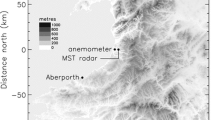Summary
Mountain wave drag is calculated for rotating, stratified, nonhydrostatic Boussinesq flow over a mountain ridge using linear theory for a variety of mountain profiles representing complex/irregular terrain. The inclusion of a sinusoidal corrugation to the familiar witch-of-Agnesi profile creates a “stegosaurus” profile. The associated drag is greatly enhanced for mesoscale mountains when the corrugation wave-number matches that for the dominant inertia-gravity wave contribution to the cross-mountain surface pressure gradient. Similarly, increasing the jaggedness (by decreasing the exponentb) increases the drag for mesoscale mountains whose topographic spectral intensity,M(k), has the form of a power law:M(k)=mk −b wherek is the zonal wavenumber.
Spectral analysis of one-kilometer resolution topographic data for the Appalachian Mountains suggests that a power law profile withb=1.7 accurately represents the topographic spectral intensity and that it yields good estimates of the drag.
The application of these results to the parameterization of mountain wave drag in general circulation models is discussed.
Similar content being viewed by others
References
Bacmeister, J. T., Pierrehumbert, R. T., 1988: On high-drag states of nonlinear stratified flow over an obstacle.J. Atmos. Sci.,45, 63–80.
Blumen, W., 1965: A random model of momentum flux by moutain waves.Geophysica Norvegiva,26, 1–33.
Bretherton, F. P., 1969): Momentum transport by gravity waves.Quart. J. Roy. Meteor. Soc.,95, 213–243.
Gill, A. E., 1982:Atmospheric-Ocean Dynamics, New York: Academic Pres, 662pp.
Godson, R. H., 1981: Digital Terrain Map of the United States, Map 1-1318.
Lilly, D. K., 1972: Wave momentum flux: A GARP problem.Bull. Amer. Meteor. Soc.,53, 17–23.
McFarlane, N. A., 1987: The effect of orographically excited gravity wave drag on the general circulation of the lower stratosphere and troposphere.J. Atmos. Sci.,44, 1775–1800.
Palmer, T. N., Shutts, G. J., Swinbank, R., 1986: Alleviation of a systematic westerly bias in general circulation and numerical weather prediction models through an orographic gravity wave drag parameterization.Quart. J. Roy. Meteor. Soc.,112, 1001–1039.
Pielke, R. A., Kennedy, E., 1980: Mesoscale terrain features. Rep. UVA-ENV SCI-MESO-1980-1, University of Virginia. [Available from R. Pielke, Dept. Atmos. Sci., Colorado 80523.]
Press, W. H., Flannery, B. P., Teukolsky, S. A., Vetterling, W. T., 1986:Numerical Recipes. Cambridge: Cambridge University Press, 818 pp.
Queney, P., 1948: The problem of air flow over mountains: A summary of theoretical studies.Bull. Amer. Meteor. Soc.,29, 16–26.
Richard, E., Mascart, P., Nickerson, E. C., 1989: The role of surface friction in downslope windstorms.J. Appl. Meteor.,28, 241–251.
Sawyer, J. S., 1959: The introduction of the effects of topography into methods of numerical forecasting.Quart. J. Roy. Meteor. Soc.,85, 31–43.
Smith, R. B., 1979: The influence of the earth's rotation on mountain wave drag.J. Atmos. Sci.,36, 177–180.
Smith, R. B., 1978: A measurement of moutain drag.J. Atmos. Sci.,35, 1644–1654.
Young, G. S., Pielke, R. A., 1983: Application of terrain height variance spectra to mesoscale modeling.J. Atmos. Sci.,40, 2555–2560.
Young, G. S., Pielke, R. A., Kessler, R. C., 1984: A comparison of the terrain height variance spectra of the front range with that of a hypothetical mountain.J. Atmos. Sci.,41, 1249–1250.
Yuhas, J. A., 1989: On mountain wave drag over complex terrain. MS Thesis, The Pennyslvania State University, University Park, PA 16802, 78 pp.
Author information
Authors and Affiliations
Additional information
With 7 Figures
Rights and permissions
About this article
Cite this article
Bannon, P.R., Yuhas, J.A. On mountain wave drag over complex terrain. Meteorl. Atmos. Phys. 43, 155–162 (1990). https://doi.org/10.1007/BF01028118
Received:
Revised:
Issue Date:
DOI: https://doi.org/10.1007/BF01028118




